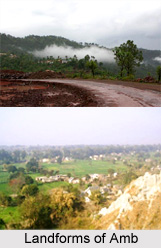 Amb is a town situated in Una District in Himachal Pradesh. Amb is situated in the Northern region of Indian Subcontinent. It is a sub-division and Tehsil of the Una district.
Amb is a town situated in Una District in Himachal Pradesh. Amb is situated in the Northern region of Indian Subcontinent. It is a sub-division and Tehsil of the Una district.
History of Amb
Amb has some ancient historical ruins of royal palaces and gardens. In the year 1877, at the request of Maharaja Ranbir Singh of Jammu and Kashmir, the British Government in India restored to Raja Ran Singh the Jagir in Jaswan, originally held by Raja Ummed Singh consisting of 21 villages in Jaswan Dun valley and the family garden at Amb, as well as palace buildings of Raja Ummed Singh at Rajpura. Raja Ran Singh died in the year 1892 and was succeeded by his son Raja Raghunath Singh who also died in 1918. Thereafter, Laxman Singh succeeded him who started residing at Amb. After expiry of Laxman Singh his son Chani Singh is living at Amb.
Derivation of Amb
The town was named Amb after the name of the goddess Amba, deity situated in nearby Chintpurni.
Geography of Amb
Amb is a plain area surrounded by mountains of the Shivalik ranges.
Education of Amb
Amb has various education institutions including a government senior secondary school, Gurukul Public School, Indian Public School, Shivalik Hill Pub Sr. Secondary. School, Sudha Model School and Maharana Pratap College being one of them. Maharana Pratap Govt. College, Amb came into being on 18th, June 1997 when the Himachal Pradesh Government took over the erstwhile National College established in 1970. The College is situated in the centre of the Amb town on the National Highway, 32 km from Una, the District headquarters, on the way to the famous shrine of the goddess.
Economy of Amb
Amb is also an industrial zone of Himachal Pradesh. Many units including Sonalika (car manufacturer) and Him cylinders are located in this town. Jindal group also established here its new textile plants. Some of the nearby places in Amb are Chintpurni, Una district, Thaneek Pura, Nehri, Daulatpur, Mairi, Lohara, Gagret, Hoshiarpur, and the last village named Ganu towards Talwara.
Visiting Information
Amb has a small bus stand. Buses are available for all major towns of Himachal and North India including Delhi, Chandigarh, Shimla, and Dharmshala. Amb is also connected with railway line. Amb Andaura railway station is situated 1.8 km from the bus stand.



















